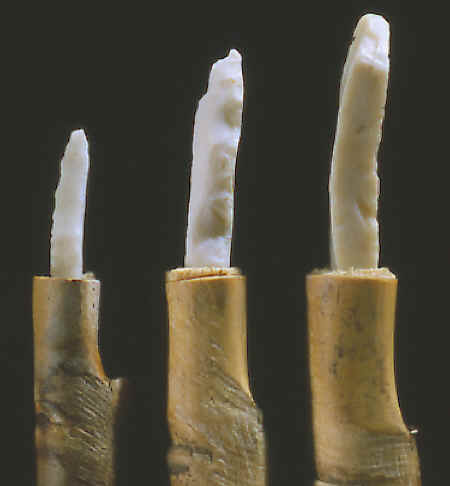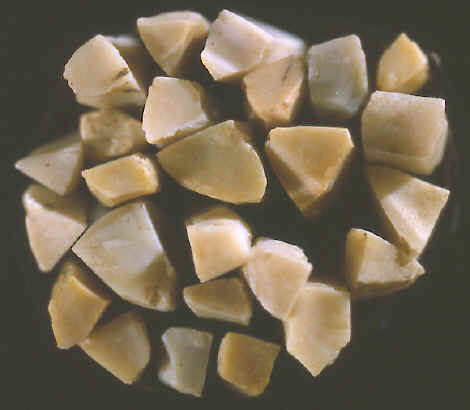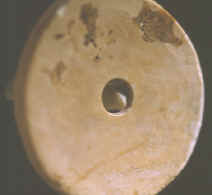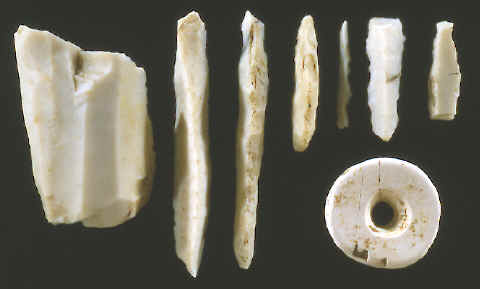|
PAGE
3 CONTINUED
FROM PAGE 2
MICRO-DRILLS
CAHOKIA MOUNDS
STATE HISTORIC SITE
MISSISSIPPIAN
CULTURE
1,150 TO 600 YEARS AGO
PAGE 3 OF 3

MICRO-DRILL SHOWING PRESSURE
FLAKES ALONG THE EDGE.
THIS DRILL MEASURES 1 1/8 INCHES (2.8CM) LONG.
|
|

HAFTED MICRO-DRILLS IN CANE
DRILLS----CAHOKIA MOUNDS
SITE--SOUTHERN ILLINOIS
GREG PERINO COLLECTION
This picture shows an edge view of micro-drills hafted on cane
shafts. The cane is cut near the growth node
so
the joint can stop the drill from pushing in too deep.
Another advantage of placing the drill near a joint is that the
"D" shaped cross section in that area is more restricted
and will hold the drill bit a little tighter than in a circular
section away from the joint. This hafting technique is possibly the
same way the Mississippian culture Indians living at Cahokia more
than a thousand years ago might have made their drills. At least
this is one way that experimental archaeology has proven micro
drills can be used to drill shell beads. |
|
|
At
least 60,000 drilled shell beads were found in Mound 72 at Cahokia.
These were divided into seven different main types or styles and within those
there were other subtypes based on size and form. There were also a number of drilled bone beads found with some of the
burials. |
|

MICRO-DRILLS WITH ONE SNAPPED
END
CAHOKIA MOUNDS
SITE--SOUTHERN ILLINOIS
GREG PERINO COLLECTION
Snapped ends are the most common micro-drill break pattern. In cross
section, most drills in the collection have four or more sides.
Drilling experiments by Larry Kinsella has shown that drills will cut better the more sides it has.
Three sided drills will not cut as well as drills with four or more
sides. |
|
|
There
have been so many drilled beads found on some archaeological sites in
the United States that it would be logical to assume that some of them
were being made by specialized craftsmen who were doing it as a
vocation. But as Morse (1983) points out "bead making must have
been a basic household activity". He bases this idea on the widely
spread distribution of drills throughout the Zebree site in northeast
Arkansas and the fact that it would have been difficult for any one
specialist to produce large quantities of beads. However, at Cahokia the
micro-blades and micro-drills are concentrated in a small area of the
site within 3.7 acres on the Kunnemann tract. The truth probably lies
somewhere in between. The largest communities or cities like Cahokia may
have had some craftsmen working with beads while the smaller villages
produced them as more of a household activity. Certainly, some of the
elaborate jewelry that was made on sites in the southwestern United
States was made by specialized craftsmen. |
|

HAFTED MICRO-DRILLS IN CANE
DRILLS----CAHOKIA MOUNDS
SITE--SOUTHERN ILLINOIS
GREG PERINO COLLECTION
This picture shows a range of sizes of micro-drills hafted on cane
shafts and the widest side of the drills showing. The drill on the
right would be used to cut the largest size of flat disc shell beads
that have been found on the Cahokia Mounds site. |
|
|
By far, most of the drilling that was being done at Cahokia was for the
manufacture of shell beads. Micro-drills were the tools being used to
accomplish that task. There is no way to know exactly how they were
being turned for the drilling process because only the stone drills
remain. The hafting materials and drilling devices have not survived in
the archaeological record. |
|

CANE HAFTS READY FOR DRILLS
This picture shows the ends of three cane shafts that are ready to
receive their micro-drills. The cane was cut around the
circumference near a joint (growth node) and snapped off. The soft
spongy pith in the center of the cane will easily hold a small drill
that is pressed down into it. |
|
|
There
were so many beads being made at Cahokia that it would be logical to
theorize that the people making them were using something like a bow
drill to turn the drill bit. |
|


DRILLED SHELL BEAD &
MICRO-DRILL
DRILLS & SHELL----CAHOKIA MOUNDS
SITE--SOUTHERN ILLINOIS
GREG PERINO & PETE
BOSTROM COLLECTION
Most holes that were drilled by micro-drills were drilled
from both sides that meet in the center. In cross section the holes are cone shaped. Both holes
together look like an hour glass shape in cross section.. |
|
|
If
what has so far been found at Cahokia is any
indication. There must be a awful lot of beads still in the ground in
and around the mounds on this site. Evidence from shell bead making
experiments show that quite a lot of time was invested in the
manufacture of those beads. |
|

A SELECTION OF DIFFERENT
STAGES OF MICRO-DRILL WEAR AND MANUFACTURE
DRILLS, CORE & BEAD--CAHOKIA MOUNDS--SOUTHERN ILLINOIS
GREG PERINO & PETE
BOSTROM COLLECTION
The eight artifacts in this picture illustrate a range of different
break patterns, manufacturing debris and a finished product, a
drilled bead. The small core, at far left, was discarded as no
longer useful by the Cahokia Indian who last used it. In the row of
six blades, the long slender flake on the left
was struck off a core but no attempt was made to finish it into a drill.
It represents a knappers' castoff. According to Morse (1983) the
most desirable blade is one that is both narrow and thick. One that
could be easily fashioned into a cylinder shape. The next one
to it is a nice long finished drill that has not had much use. The
third one over has seen a lot of use from both ends. The fourth one
over is a very small fine tipped micro drill. It's much smaller that the
average size found at Cahokia. The two on the far right were both snapped---probably
from use. The one on the end was snapped on both ends and the second
one over was snapped only on the upper end. The flat disc shell bead
is the most common type found at Cahokia. It was drilled, as all of
them probably were, with stone drills.
The shell bead in this picture measures 5/8 inch
(1.6cm) in diameter. |
|
|
Morse
(1983) states that drilling experiments showed that it took about 10
minutes to drill a bead. Larry Kinsella timed the process a little above
that. If it took 10 minutes to drill a bead during the Mississippian
period at Cahokia the drilling process of the 60,000 beads found in
Mound 72 alone would have taken 1,250 eight hour days of steady work to
complete! |
|
"REFERENCES"
1896,
"A Study of the Primitive Methods of Drilling", by J.D. McGuire,
pp. 707, 721, 734, 737.
1912, "Handbook of North American Indians, North of Mexico", by
Frederick Webb Hodge, pp. 401-403.
1976, "The Evolution of Man", by J. Jelinek, p. 175
1978, "Jewelry of the Prehistoric Southwest", by E. Wesley
Jernigan, pp.197-201.
1983, "Archaeology of the Central Mississippi Valley", by Dan F.
Morse and Phyllis A. Morse. pp. 222-224.
1988, "Encyclopedia of Human Evolution & Prehistory," by Ian
Tattersall, E. Delson & J. V. Couvering, pp 63-64.
1989, "The Cahokia Atlas", by Melvin Fowler, pp. 229-230.
1999, "The Mound 72 Area", by Melvin L. Fowler, J. Rose,
Barbara V. Leest & Steven R. Ahler. pp. 132-137
2002, Personal communications with Larry Kinsella.
|
|
HOME
ORDERING |







